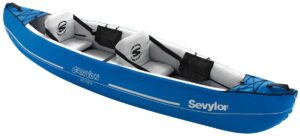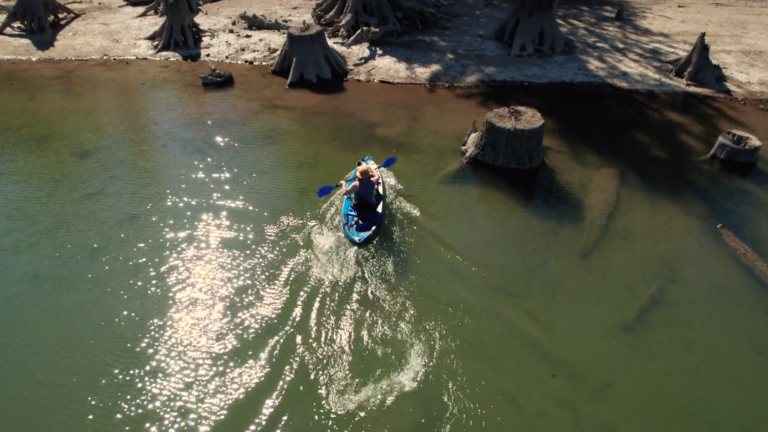When my partner and I decided to make a move from the city to the coast, there was a whole lot to look forward to. I had grown up beside the sea but had lived most of my adult life in landlocked cities. So, I’d almost forgotten what it was like to be able to avail of everything the sea has to offer in the way of sport and leisure.
The only issue was that my ‘significant other’ was a rookie when it came to watersports. She had never kayaked or canoed in her life. But she was anxious to learn and was pushing me to teach her the basics. I felt that the best option was a two-person craft but I didn’t want to spend a fortune of one.
I had no idea if this little venture was going to be successful or not and, if it wasn’t, what was I going to do with it if she didn’t take to it? I couldn’t really use it on my own! Reselling anything sport-related that’s designed for use by two people is notoriously difficult, especially if it’s an inflatable product, and I didn’t want to just throw my cash away.
So, we visited our local Decathlon, which is a French sports superstore with outlets all over Europe. They have a reputation for selling affordable, quality sporting goods at a reasonable price and I felt it was a good place to start.
Insofar as the budget was concerned, we didn’t want to go over about $300 just in case the kayak ended up rotting away in our garage. I hadn’t been on the market for any type of kayak in a long time and I was surprised to see that there was a pretty decent range of products available.
The whole world of kayaking had clearly come a long way since my days of flimsy fiberglass K1 sprites when I was in the Sea Scouts in my hometown of Howth, Dublin. Decathlon sells inflatables produced by a company called Sevylor, which began business in the late 40s in France and made a name for itself in PVC and vinyl inflatables. It’s now a US company that operates out of Huntington, CA.
Table of Contents
ToggleSevylor Canyon Kayak Features

The range of inflatable kayaks was pretty impressive: they had single-user crafts for $200 and, on the other end of the spectrum, three-person kayaks for a little over $1,500.
Most of them were sea blue with a dash of sunflower yellow and, to be honest, I couldn’t really figure out why one two-person kayak or canoe was priced differently to another, in spite of them appearing to be pretty much the same thing with slightly different designs.
For us, the choice was easy: we were going to buy the cheapest one! That was the Canyon SC320 model, which retailed for $249 and for that price, you got the following:
- A 320cm x 90cm (when inflated) kayak
- Two surprisingly decent paddles
- Two mesh bags that attached to the inside of the kayak
- A removable fin ‘for maneuverability’ (useless)
- A PVC floor beam that slots in snugly
- A transport bag
- Pump and repair kit
- An air-pressure gauge
My Experience With The Sevylor Canyon

Fast-forward a couple of weeks and we’re pulling the kayak out of its storage bag down at what was now our local sandy beach (El Arenal, Xàbia – Alicante, Spain). When I saw how compact the deflated product was, I wondered if I was going to be capable of squeezing it back into that bag once we’d used it.
We unfurled it, set up the pump (a two-handed plunger) and unscrewed the cap where you connect it up for inflation and inserted the pump nozzle. I did the gentlemanly thing and insisted on doing the hard work. It was early August, temperatures were in the very high 30s (centigrade) and it wasn’t long before the sweat began pouring off me.
This, clearly, was the first downside of having an inflatable kayak: the unwanted workout. It took me the guts of 20 minutes to inflate the kayak and the floor beam. The fact that the pump doesn’t have a built-in pressure gauge is another issue because you have to stop pumping, disconnect the nozzle, insert the pressure gauge, take the reading and then reinsert the pump to continue the hard slog until you have the required pressure. I wanted our kayak to be as rigid as possible.
There are, of course, electric pumps available that you can connect to your car but that would have meant an additional cost, which we didn’t feel was worth it in the case of the Canyon.
The inflatable seats are secured by back-straps and take about an additional five minutes to inflate. There’s also a strap dividing the paddlers that pulls the mid-section of the kayak together to make it more aquadynamic. It’s worth noting that the maximum load capacity for the Canyon is around 165kg.
Once all the pumping was done, we carried it to the shoreline. I have to admit that, once it’s inflated, the Canyon feels pretty solid and at just under 13kg, it’s not at all heavy. We decided to pass on the mesh bags because we had our own 10-liter airtight containers and I didn’t want any clutter inside the kayak that could potentially have an impact on comfort and paddling.

The bags are supposed to clip onto the inner left side of the Canyon. It looked like too much of a squeeze. Plus, anything you store there could get wet so, what’s the point of them? Those mesh bags never saw any use and, quite frankly, I think they’re a waste of time. The kayak has bow and stern bungees for storage but we opted for squeezing our containers under the spray covers. It made more sense and they fit quite snugly.
As soon as we were on the water, the first thing I liked about the Canyon was its comfort. I mean, it’s like sitting inside a blue, carved-out banana made of foam. It’s incredibly comfortable! This was my partner’s first time on the water in a kayak and she was up front, receiving the occasional instruction from me, the back-seat driver.
It wasn’t long at all before we had synched our paddling and were heading out of the little bay to hug the coast for a few kilometers. My area only has one sandy beach. Everything else is rocky and pretty unforgiving. I was concerned that we might damage the material of we pulled up into any of the local coves.
If you swim around here, solid footwear is essential as the coast is mostly limestone, which can be very pointy. You also have to factor in the Sea Urchins – they’re everywhere and their spikes are very tough indeed. So, a certain amount of precaution is required when using anything inflatable in that kind of environment.
With respect to the removable fin, I genuinely feel that it’s completely useless. We actually forgot it on a couple of occasions and it made absolutely no difference to the Canyon’s performance.
A Durable Inflatable Kayak

The Canyon is not a flimsy craft. As long as you don’t ram it into anything sharp, it can stand up to a surprising amount of punishment. We used it all summer and were delighted with its performance. The Canyon’s stitching is very resistant and the PVC floor beam insert gives you an extra inch or so of elevation, which adds to the overall comfort. Given its canoe-like design.
You feel quite ‘cozy’ and secure because you’re literally sitting inside it and not on it, as you would with a ‘normal’ sit-on kayak. We were extra-careful not to attempt to pull it onto anything that looked pointy or sharp to avoid punctures. Although it doesn’t take on much water, if you do end up in slop and get some inside, emptying it out is a bit messy due to the spray covers, which tend to actually trap the water inside. Having said that, it’s not a deal-breaker.
By the end of the summer, we were managing to squeeze our two air-sealed containers and a tent into the canyon and we spent quite a few nights camped out in the different coves along the coast. When we had visitors, the fact that it’s a two-person kayak meant you could take rookies or a kid with you and feel quite safe and comfortable. Capsizing the Canyon would take some effort, as it’s almost a meter wide at the mid-section and quite stable.
We became quite attached to our Canyon and did manage to squeeze it back into its bag after every use. However, once we were at home, we had to pull it out again to hose it down. Letting salt water soak into the outer layer would undoubtedly have caused it to rot and eventually fall apart.
Conclusion: Last Words On The Canyon
Inflatable paddleboards are becoming increasingly popular in recent years and some of them are incredibly well designed. Manufacturers have invested in technology and design to produce a variety of quality products to meet the increasing demand for this type of board.
The same cannot be said of inflatable kayaks, in my view. I live in a part of the World where watersports are the norm almost all year-round and I have observed how this type of kayak has not exactly come on in leaps and bounds. The basics seem to have remained the same: inflatable bladders inserted into shells designed for use by one, two or three people.
Sure, some of them now have fancy colors, rudders and smaller bladders to reduce inflate time but unlike paddleboards they’re essentially the same as they were ten years ago.
I would recommend the Canyon if you’re planning on doing a bit of kayaking on your local lake or bay during the summer. It really is value for money and you get what you pay for: a cheap, easy to use kayak that won’t stand up to too much abuse, requires a bit of general care but is perfect for some summer fun.
Adelaide Gentry, a seasoned kayaking enthusiast and expert, is the driving force behind KayakPaddling.net. With over a decade of experience navigating the world’s most challenging waterways, Adelaide combines her passion for adventure with a deep knowledge of kayaking to provide insightful and practical guidance for paddlers of all levels.
Related Posts:
- Top 10 Best Inflatable Kayaks 2024: Portable + FUN
- Heavy Duty Fishing: 11 Best Rods And Reels For Big Fish 2024
- 4 Best Places to Go Kayaking In and Near Washington, DC
- 5 Best Places to Go Kayaking In and Around Houston, Texas
- 6 Best Places to Go Canoeing and Kayaking in San Francisco
- 12 Best Motorized Kayak 2024 - Start Your Aquatic Adventure!












